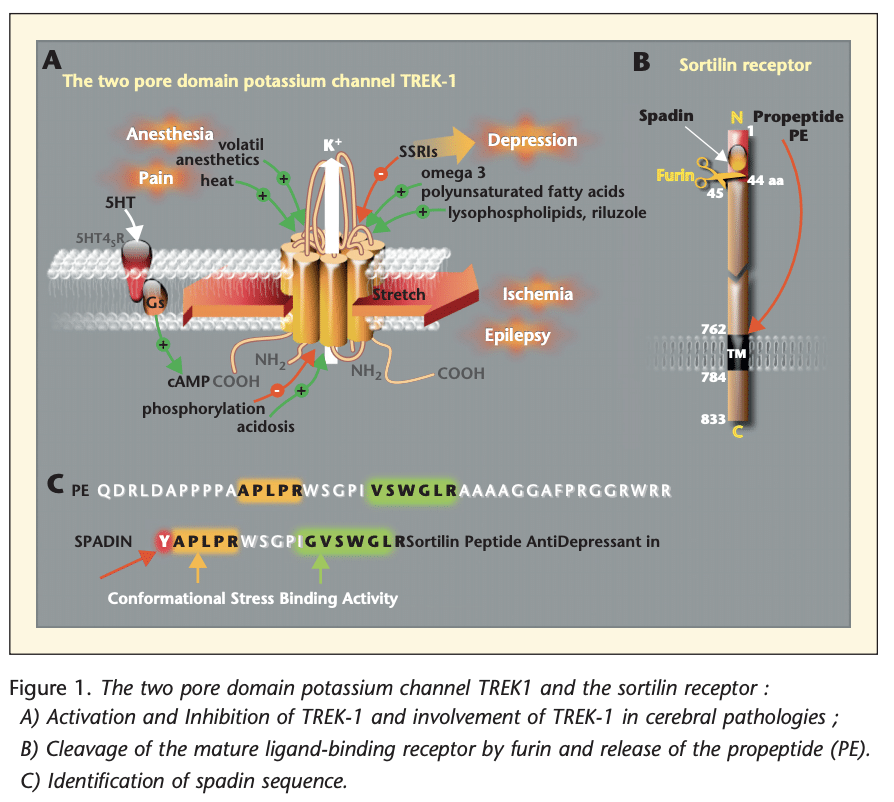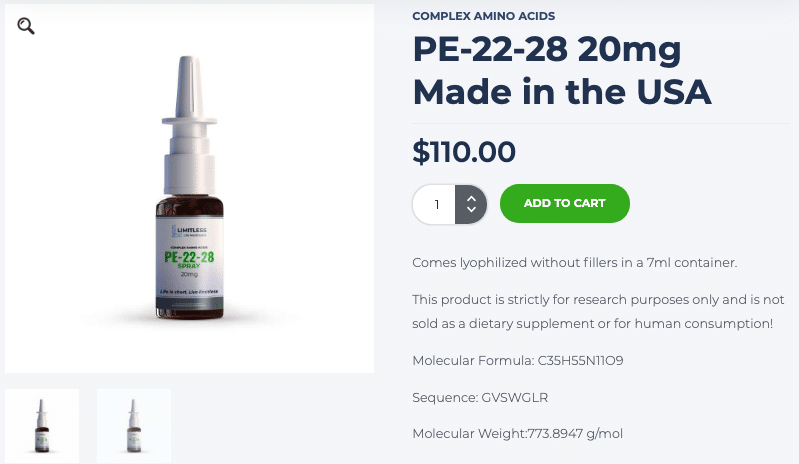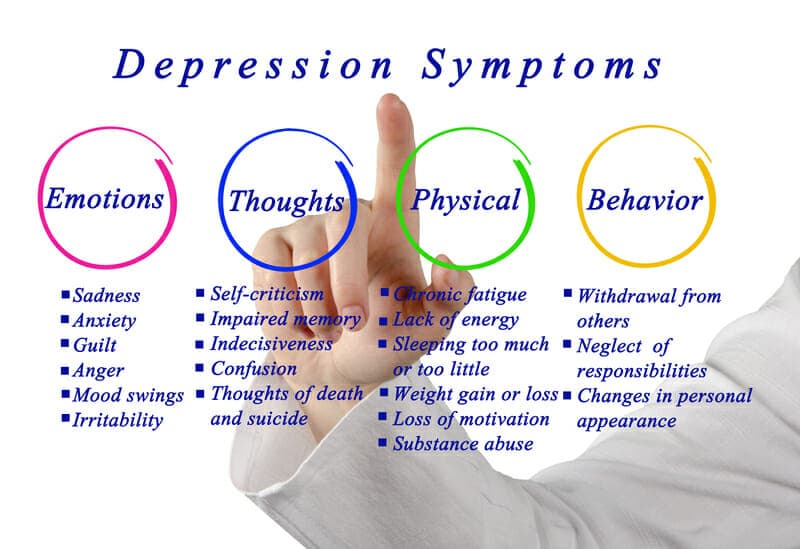Long before the ongoing pandemic, depression has been an ages-old problem affecting more than 260 million people worldwide.
Regardless of age, status, or even health, depression can easily find its way into your life at the most inconvenient time and manifest itself in the worst ways possible.
But could there be a therapeutic peptide that treats depression?
One which acted faster and lasted longer than conventional drugs with fewer side effects?
PE-22-28 appears to be the newest peptide for fixing major depressive disorder, at least according to world-renowned peptide physician Dr. Elizabeth Yurth.
This article will explore this newly discovered molecule in detail, while exploring a little-known mechanism for depression that explains why some people are just “naturally” happy no matter what life throws at them.
Table of Contents
ToggleWhat Is PE-22-28?

PE-22-28 has a disjointed history behind its discovery that appears confusing at first, so I’ll first need to talk about two of its predecessor molecules.
Back in 2006, the TWIK-related potassium channel-1 (TREK-1) protein was discovered as a potential drug target for treating depression:
“The TREK-1 protein is a background K+ channel regulated by various neurotransmitters including 5-HT [serotinin].
In mice, the deletion of its gene (Kcnk2, also called TREK-1) led to animals with an increased efficacy of 5-HT neurotransmission and a resistance to depression in five different models and a substantially reduced elevation of corticosterone levels under stress.
TREK-1-deficient (Kcnk2-/-) mice showed behavior similar to that of naive animals treated with classical antidepressants such as fluoxetine”
From this emerged a new goal for scientists: Inhibit TREK-1 via a potent antagonist and you have a shot at fixing depression.
TREK-1 was especially interesting as it was also discovered to play a role in strokes, particularly a type of depression called “Post-stroke depression” (PSD).
This led to French scientists Catherine Heurteaux and Marc Borsotto discovering that TREK-1 activity was regulated by a protein called Sortilin:
“NTSR3 [neurotensin receptor-3]/Sortilin is a 95–100-kDa type-1 membrane protein, consisting of a large luminal domain, a single transmembrane segment, and a short C-terminal cytoplasmic tail.”
“In the rat brain, NTSR3/Sortilin as well as TREK-1 are highly expressed in cerebral structures involved in the pathophysiology of depression, such as prefrontal and cingulate cortice, amygdala, hippocampus, nucleus accumbens, dorsal raphe, and hypothalamus”
After further investigation, it turns out a 44-amino-acid propeptide (PE) released by this membrane protein into the bloodstream was responsible for TREK-1 blockage:
“Propeptide binds to the mature receptor with a high affinity (Kd∼5 nM). Structure-function relationship studies have identified that the peptide Gln1-Arg28 was as efficient on the binding activity as the entire propeptide Gln1-Arg44, whereas the affinity of the peptide Gln1-Arg16 was very low”
This resulted in the creation of Spadin (PE 12-28) in 2010:
“Therefore, we designed the peptide spadin by conserving the sequence 17–28 in which we added the sequence 12–16 (APLRP) in order to maintain conformational stress. This partial propeptide (Ala12-Arg28) was tested for its potential effects on TREK-1 channel regulation and for its validation as an antidepressant drug in five behavioral models of depression.
While Spadin exerted significant antidepressant effects that took place in 4 days without unwanted side effects (versus fluoxetine, a conventional treatment that took weeks to demonstrate its effects), this peptide was not without its flaws:
“In vivo tests showed that the AD effects of Spadin disappeared 6 hours after injection. We then researched and identified analogues with the same properties but with greater efficacy and in vivo bioavailability.”
So even though Spadin did a much better job of blocking TREK-1 than both the original PE and fluoxetine, it was still an unviable drug target.
After looking at much shorter analogs of Spadin, the 7-amino acid peptide PE-22-28, a.k.a. Mini-Spadin [Gly-Val-Ser-Trp-Gly-Leu-Arg (GVSWGLR)] was eventually discovered and synthesized in 2017:
“In vitro studies on hTREK-1/HEK cells by using patch-clamp technique, showed that PE 22-28 displayed a better specificity and affinity for TREK-1 channel compared to spadin, IC50 of 0.12 nM vs. 40–60 nM for spadin.”
(For context, this means it takes ~333-500x LESS PE-22-28 to inhibit 50% of TREK-1’s biological function compared to Spadin)
Not only does its stability last a longer 23 hours, but further studies — more on that later — prove PE-22-28 to be a natural and fast-acting therapeutic peptide that may treat depression better than other TREK-1 blocking antidepressants such as Cilatopram and Paroxetine.
How Does PE-22-28 Work In The Human Body?

The mechanism of action for PE-22-28 that explains the hype behind it being a peptide for treating depression should now be obvious:

(Source)
But as it turns out, TREK-1 is located in numerous parts of the brain and body and is influenced by multiple factors:
“TREK-1 is activated by volatile general anesthetics, membrane stretch, heat, acidosis, but also by riluzole, polyunsaturated fatty acids and lysophospholipids. These openers prevent neuronal death in animal models of epilepsy, stroke, global, retinal and spinal ischemia”
We don’t know the precise mechanism through which TREK-1 inhibition directly leads to a reduction in depressive symptoms, but the connection is well established in humans:
“among the 751 [patients with major depressive disorder] who entered next-step treatment, variants in KCNK2 [TREK-1] were associated with treatment response.
In follow-up analyses, KCNK2 was also associated with effects of similar magnitude for third-step treatment among those with unsatisfactory benefit to both citalopram and one next-step pharmacotherapy (n=225).
These findings indicate that genetic variation in KCNK2 may identify individuals at risk for treatment resistance.”
And although we’ve already seen evidence of this same mechanism in mice, the following insight provides more clarity:
“The TREK1 ion channel is regulated by G-protein-coupled receptors including several types of serotonin receptor, is homologous with other ion channels controlled by serotonin and is expressed in areas of the brain believed to mediate cognitive aspects of depression.
…In all the models, mice lacking TREK1 were more resistant to developing symptoms linked to depression than were wild-type mice. Moreover, the behaviour of TREK1-deficient mice closely resembled that of wild-type mice that had been treated with SSRIs.
Electrophysiological tests of serotonin-responsive neurons in the brain showed that, compared with wild-type neurons, the neurons of TREK1-deficient mice had an increased level of activation, as if they had been chronically treated with an antidepressant.
Consistent with the involvement of serotonin, depletion of the neurotransmitter using a combination of agents to block its synthesis, reuptake and recycling reversed the depression-resistant phenotype of TREK1-deficient mice.”
Not much to go off of, but such is the nature of newly discovered compounds.
We know something WORKS but not the exact mechanism behind WHY it works.
PE-22-28 Benefits

You’ll be very hard-pressed to find legitimate information online about PE-22-28, and everything we know about its precursor Spadin has just been discovered in the last 15 years.
That doesn’t stop researchers from speculating about PE-22-28’s many applications: Enhancing one’s mood, recovering from strokes, alleviating depression, and much more.
Let’s see what the available science has to say about PE-22-28 and its health benefits…
Treating Depression
Two studies in mice verify PE-22-28 as an alternative to many antidepressant medications.
The first one examines PE-22-28 in various models of depression, which happens to be the same study where it was discovered and applied:
“In vivo, the antidepressant properties of PE 22-28 and its derivatives were demonstrated in behavioral models of depression, such as the forced swimming test. Mice treated with spadin-analogs showed a significant reduction of the immobility time.
Moreover, in the novelty suppressed feeding test after a 4-day sub-chronic treatment PE 22-28 reduced significantly the latency to eat the food pellet”
The second one pertains to TREK-1 inhibition rather than PE-22-28 itself, yet the results confirm the observations of the first study:
“Knockdown of TREK-1 in hippocampal neurons significantly attenuated depressive-like behaviors and prevented the decrease of CUMS [chronic unpredictable mild stress] induced synaptic proteins in mice.
Further examination indicated that neuron-specific knockdown of TREK-1 in the hippocampus prevented stress-induced impairment of glutamatergic synaptic transmission in the CA1 region.
Moreover, chronic TREK-1 inhibition protected against CUMS-induced depressive-like behaviors and impairment of synaptogenesis in the hippocampus.
So even in situations where high levels of stress can bring about depression, PE-22-28 may be able to stop people from “spiraling down” into deeper levels of misery.
Dr. Yurth can personally attest to this, stating how PE-22-28 can be great for people who undergo long-lasting situational depression:
“As I said, when I lost my mother, father, and sister, in a short period of time, I became very depressed. And it caused me a lot of grief for about a year. But I knew I would get past it…
…but taking an SSRI. Was it an option? Because I know it takes 4-6weeks for it to actually start to work and it doesn’t work for most people, and if it doesn’t work, then it’s going to take me four to six weeks to feel normal again and what’s normal by then.
…Now look at PE 22-28. Let’s say you lost your job, you’re really depressed, you’re sad, but you know you’re going to feel better. You just don’t want to feel this way for the next couple of months until you snap out of it. Here’s something that kicks in fast and you can just stop when you’re done… this would be a much better rescue method”
May Be Effective For Stroke Recovery
One of the unfortunate outcomes of stroke is the depression that follows:
“Poststroke depression (PSD) is common, affecting approximately one third of stroke survivors at any one time after stroke.
Individuals with PSD are at a higher risk for suboptimal recovery, recurrent vascular events, poor quality of life, and mortality.
Although PSD is prevalent, uncertainty remains regarding predisposing risk factors and optimal strategies for prevention and treatment”
Fortunately, TREK-1 inhibition is a viable target for treating both stroke and depression.
And if this can happen without increasing the chances of a second stroke, all the better.
PE-22-28 was able to achieve the two outcomes simultaneously, according to 2018 findings published at a conference that were published the following year:
“Chronic treatment with spadin or a shorter analog (PE 22-28) improved the post stoke recovery from days to months after the ischemia.
…Treated mice showed a significant reduction of the immobility time in the Forced Swimming Test. The eat latency in the Novelty Suppressed Feeding test was significantly reduced.
…The learning capacity was increased in the Morris Water Maze and the motor coordination was improved in both rotarod and pole test. The increase in neurogenesis, measured by BrdU incorporation was still present even at 10 weeks post trauma.”
Other worthwhile reports from the study include “reduces the mortality rate, prevents weight loss and reduced motor and cognitive dysfunctions induced by ischemia” (Source)
And even though the first predecessor Sortilin is heavily implicated in cardiovascular disease, Spadin “does not display side effects at the cardiac level and on TREK-1 controlled functions such as stroke, epilepsy or pain” (Source).
So far, all signs point towards the need to test PE-22-28 in human clinical trials for this benefit.
Could Be Useful for Improved Memory and Learning
For anybody suffering from neurodegenerative disorders, PE-22-28 may offer the level of neuroprotection you are looking for.
If Spadin can reliably increase production of BDNF (brain-derived neurotropic factor) and lead to synthesis of new neurons, so can PE-22-28:
“Spadin increases transiently and after 8 h the mRNA expression of PSD-95 and synapsin, two markers of synaptogenesis in the brain.
This increase is associated with a transient BDNF increase only after 5 h. Spadin increases also the proportion of mature spines in cortical neuronal culture.
In vivo, daily spadin administration for 4 days increased mRNA expression of BDNF, PSD-95 and synapsin after only 7 days in the hippocampus. However, in the prefrontal cortex (PFC), only BDNF was enhanced after 3 weeks”
Fortunately, the synaptogenesis described above is also observed with PE-22-28:
“Mini-spadin increased the synaptogenesis marker PSD95 levels after only 24 hours of treatment, suggesting that like spadin, mini-spadin was able to induce neurogenesis and synaptogenesis.”
(FYI – “Neurogenesis is the process by which neurons are generated from the neural stem cells and progenitor cells, while synaptogenesis is the formation of synapses between neurons in the nervous system” (Source))
Both processes are the foundation of neuroplasticity, which gives your brain the lifelong ability to rewire itself and acquire new habits/skills and information.
None of this is surprising given that neuroinflammation in diseases such as Alzheimer’s directly leads to the opposite outcome:
“Inflammation has largely stimulatory effects on CRF (corticotropin-releasing factor) and NE (norepinephrine) while it generally serves to suppress 5-HT and BDNF along with BDNF’s activated receptor, phosphorylated TrkB.
We hypothesize that a milieu of elevated inflammation initiates a cascade of adaptations within these stress sensitive systems to contribute to a susceptible phenotype that is primed to develop depression and CVD.”
Not to mention BDNF production is downregulated by TREK-1 overexpression, which is yet another reason why PE-22-28 should be used for aging patients who struggle with memory and learning.
More neurogenesis = depression is being treated and biological pathways which are deficient and nonfunctional are being restored to normal function.
PE-22-28 Dosage for Treating Depression

I defer to Dr. Elizabeth Yurth for her expertise since she’s the ONLY physician I know who has direct experience with using PE-22-28 on patients suffering from major depressive disorder:
The best PE-22-28 dosage for depression is 400 mcg administered intranasally once a day in the morning.
With this being said, Dr. Yurth recommends experimenting with the dosage depending on how you feel:
“Higher doses, like 800 micrograms, uh, can cause some lethargy. In some people, not everybody. Uh, it’s a very interesting peptide, great for depression, but also cognitive enhancer, which Victor had said that, you know, he has a nootropic effect”
“have also had great success with just 400 micrograms improving cognition and no lethargy… if you stay under 600 microgram“
“Intranasally the research has shown is it works better intranasally than injected. I do think you get affected that you need a higher dose… I may recommend the dosing being being twice, so two sprays [one in each nostril]… 400 in each”
If you get PE-22-28 from a source that requires reconstitution into a nasal spray, the video tutorial below is very helpful:
PE-22-28 Side Effects: Are There Any?

As PE-22-28 is a new peptide that does not have a single published study in human subjects, we can only speculate on how safe it will be.
But we do have some data suggesting there is nothing to worry about.
In a patent outlining the use of PE-22-28 for depressed patients, the low amount needed for a clinically significant effect is already a testament to the peptide’s safety:
“Given the better affinity and the smaller size of the Spain analogues, the main advantages of these peptides are firstly a reduction in the quantity of product to be administered, hence a reduction in the potentially associated side effects (toxicity, tumorgenicity , etc …), and secondly a reduction in the cost of production as well as its availability for any known route of administration (icv, iv, ip and oral)”
However, one possible side effect of TREK-1 inhibition is increased sensitivity to pain, ischemia, and seizures (Source).
Which is why Spadin luckily doesn’t lead to that outcome in rat models, and theoretically neither should PE-22-28:
“…spadin did not interfere with other TREK-1 controlled functions such as pain, epilepsy and ischemia.
We also demonstrated that spadin was unable to inhibit currents generated by TREK-2, TRAAK, TASK and TRESK four other K2P channels.
More importantly, spadin did not induce cardiac dysfunctions, did not block IKr and IKs and did not modify the systolic pressure or cardiac pulses.
After a three week treatment spadin remained an efficacious AD and did not modify the infarct size in brain following focal ischemia. Finally, we showed that kainate induced seizures and glycemia were not modified by spadin treatments”
Spadin also demonstrates an excellent central nervous system (CNS) safety profile in rats when compared to traditional stimulants (such as cocaine, Adderall and caffeine) and antidepressants:
“Spadin was devoid of effects on sleep wake cycle up to 1 mg/kg (IV). Moreover, it caused no change in EEG rhythm power whatever the sleep/wake cycle.
Likewise, spadin had no effect on short and long term memory up to 1 mg/kg (IP).
All other CNS stimulant agents caused sleep disturbances and/or decreased short term memory ability.”
Here are 3 more great reasons why we can trust PE-22-28 to have next to no side effects while being equally (if not more effective) than classical antidepressants:
“Natural peptides: In addition to the fact that they are natural peptides, we can reasonably expect a high level of specificity and safety for these peptides. Converse to the majority of actual ADs that provoke withdrawal behavior, the probability to observe such a phenomenon with a natural peptide is low
“Biomarker: Spadin-like activity in the serum, mainly corresponding to PE and its degradation products, is significantly decreased in patients suffering from MDD in comparison to healthy controls”
“Fast-acting: Current marketed AD drugs often take several weeks to be efficient. Spadin or its analogs only need 4 days to exert their AD effects. Additionally, spadin and its analogs are effective regardless of the route they are administered: intravenous, intraperitoneal, intracerebroventricular, subcutaneous, or per os.”
Now compare all this to the long laundry list of problems associated with the current generation of antidepressants, and PE-22-28 suddenly seems like a great sell:
“Several side effects are transient and may disappear after a few weeks following treatment initiation, but potentially serious adverse events may persist or ensue later.
They encompass gastrointestinal symptoms (nausea, diarrhea, gastric bleeding, dyspepsia), hepatotoxicity, weight gain and metabolic abnormalities, cardiovascular disturbances (heart rate, QT interval prolongation, hypertension, orthostatic hypotension), genitourinary symptoms (urinary retention, incontinence), sexual dysfunction, hyponatremia, osteoporosis and risk of fractures, bleeding, central nervous system disturbances (lowering of seizure threshold, extrapyramidal side effects, cognitive disturbances), sweating, sleep disturbances, affective disturbances (apathy, switches, paradoxical effects), ophthalmic manifestations (glaucoma, cataract) and hyperprolactinemia.
At times, such adverse events may persist after drug discontinuation, yielding iatrogenic comorbidity”
Case in point!
Where to Buy PE-22-28 Online

Due to PE-22-28 being both extremely new to the peptides community and unknown in its status, you’ll find around 5 vendors who sell it for research purposes.
Yet as you all already know, Limitless Life Nootropics is the ONLY supplier I would trust to synthesize and distribute a therapeutic peptide of this nature.
Use code JAY15 to get 15% off your order!
As of this writing, PE-22-28 is a very new addition to Limitless’ catalog and it won’t be in stock forever.
So if you or someone you know is open to experimenting with unconventional solutions for depression… grab a bottle or two while they’re still available.
Additional Reading Resources For PE-22-28 (And Treating Depression)

PE-22-28 barely has any research behind its name and so it’s no surprise to find a lack of intel about this novel peptide.
But in the interest of helping men and women escape the suffering brought about by depression, here are some additional guides for exploring the link between peptides and depression…
I highly encourage you to listen to Dr. Yurth’s podcast on SuperHuman Radio (and the transcript) dedicated entirely to PE-22-28
Peptide Sciences put together a theoretical guide for combining PE-22-28 with peptide SS-31 for improving heart health, memory, and mood.
Ryan Smith of TruDiagnostic did a short podcast on using the peptides Selank and Semax for treating depression and anxiety.
I have a number of podcasts I’ve done on the subject of depression with Dr. Mark Gordon and Rob Kilmartin, along with several episodes about finding and healing trauma.

NOTE: Please remember that depression is multi-factorial — it can present in one or multiple symptoms, all stemming from one or several causes (see the above picture).
A powerful peptide can be a useful addition to a toolbox but it is just one of many available modalities for fully optimizing your mental health.
From the music you listen to, to the foods you eat, everything you do in your life can make or break the difference between happiness and sadness.
And as always…
Raise Your Vibration To Optimize Your Love Creation!
PS – When you’re ready to learn how to use peptides at a much deeper level, you have two options.
- You can set up a private One on One Call with me.
- Joining The Fully Optimized Health Mastermind with two Monthly 60 Minute Group Coaching Calls with Me and Daniel Kelly Discussing Fully Optimized Living including Peptides, Hormones, Gray Market Agents, Performance Enhancement and Raising Your Vibration.



